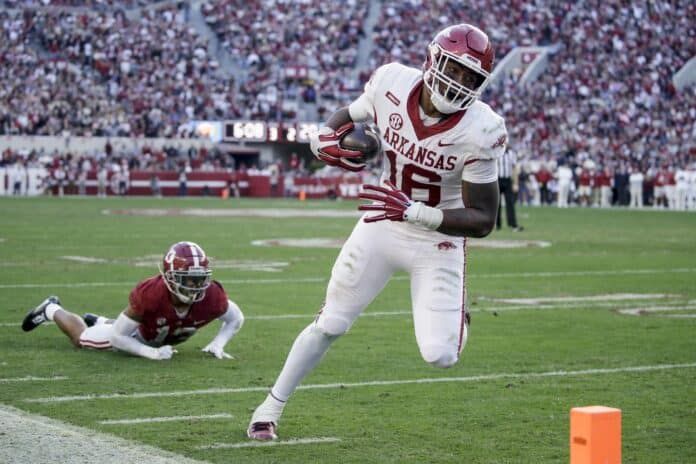Treylon Burks brings a unique mix of size and athleticism to this year’s NFL Draft. While no Arkansas Razorback wideout had been selected in the first round since 2005 (Matt Jones), Burks has officially broken that streak. The question for dynasty fantasy football managers is whether Burks has what it takes to be a long-term asset as a wideout who belongs in weekly fantasy lineups. How should dynasty managers assess Burks, and does his landing spot elevate his dynasty fantasy value?
Treylon Burks’ dynasty fantasy profile
It’s evident from Burks’ scouting report that he demonstrated exceptional growth as a collegiate wide receiver. Now, which factors could impact his longer-term floor and ceiling?
Strengths
A frequent topic of discussion around first-round-caliber receivers, Burks shined these past two seasons at Arkansas. He racked up a combined 117-1,924-18 receiving line across his sophomore and junior campaigns. There’s little more to prove at the collegiate level, particularly after he helped lead the Razorbacks to a 9-4 record in 2021 — their best mark in 10 years.
Burks’ famously large hands are his calling card. He needed custom-made gloves for game days. Big hands and a big frame (6’2″, 224 pounds) give him the physicality and catching ability to shine at the professional level.
According to PFN’s NFL Draft Senior Director Cam Mellor, “Burks runs the draft class’ best 9 route (or go route). He essentially uses his insane combination of speed and size to quickly gather on defensive backs and run right by them.”
Burks appears ready to contribute as a rookie.
Weaknesses
Burks’ weight has been an issue. During Combine training, he pushed past 230 pounds — and it showed in his route running. Along those lines, Burks might need to expand his repertoire.
His route tree at Arkansas was reportedly not expansive. Additionally, mental lapses sometimes negate his size advantages. In the NFL, there’s less room for error.
Burks also disappointed in the athletic testing drills at the Combine. Many were expecting him to run the 40-yard dash in the 4.4s. Instead, he ran a 4.55. It’s still good for his size, but he struggled in other drills, resulting in a mediocre burst score and bottom-tier agility score.
There was a point when Burks was considered to be the best wide receiver in this class. That is no longer even remotely the case, with some even dropping Burks outside their top five.
Burks’ injury history
A torn ACL cut Burks’ senior season short at Warren High School. However, he missed only one game due to injury these past two seasons at Arkansas. There are no notable yellow or red flags.
Burks selected by the Tennessee Titans
Well, this was unexpected. Not so much for Burks to be a first-round pick, but the circumstances. There were reports that A.J. Brown was unhappy as he entered a contract year. Well, the Titans remedied this by trading Brown to the Eagles in exchange for picks No. 18 and No. 101. What did Tennessee do next? They drafted a receiver many compared to Brown — Burks.
Let’s just examine the role Burks is filling. In Brown’s three years with the Titans (43 games), he recorded a 23% target share with 26.5% over the last two seasons. He also saw 44% of the wide receiver targets the last two seasons with 45% of the yards. That equated to nearly 3,000 yards and a 15.1 PPR/game average along the way.
I’m not willing to call Burks the next Brown, but it’s a compelling argument to make in terms of role and the size factor. With Robert Woods coming back from a mid-season ACL tear, Burks is set to be a substantial part of this Titans’ passing attack.
While it is a run-first team with Derrick Henry, Ryan Tannehill’s passes are generally efficient. That will translate to Burks and his potential. Burks is one of the few receivers who are stepping in as a rookie into a role with an upside of 25% or more of the team targets. Burks is set to silence the critics and show that 40 times are not the be-all-end-all of evaluation tools. Burks is a solidified top-three receiver in upcoming rookie drafts with a yearly high-end WR2 ceiling.

